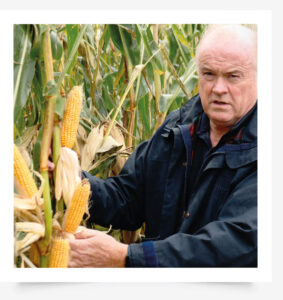Extending maize rotations to elevate crop performance24 January 2024
With sustainable farming payments making cover cropping financially attractive, maize growers are beginning to re-assess how best to manage stubbles after harvest.
While it may be tempting to use a basic cover crop to protect bare soils, there are better ways of achieving this, with evidence suggesting that widening the rotation is a superior approach, especially where maize is currently being grown continuously.
Growing consecutive crops of maize can cause a range of problems including degradation of soil structure, depleted microbial and biological activity within the soil, pH imbalance, increased weed pressure, and nutrient losses caused by leaching and run-off.
“It isn’t always easy to rotate crops, especially on land located away from the main farm,” explains ProCam agronomist Merfyn Parry, “but there are ways growers can boost the benefits of cover cropping beyond simply securing sustainable farming payments.”
Merfyn explains that the minimum growers should be doing is to ensure maize stubbles are covered as soon as possible after harvest.
“If conditions allow, grass can be under-sown into the young maize crop to provide cover before the crop has been harvested. Where this isn’t feasible, the next best option is to establish a grass ley as soon as possible after the maize has been cleared. In both scenarios, the cover crop will give growers the option to over-winter livestock and to take an early cut of grass silage before the next crop of maize goes in.”
While this basic system should be feasible in most circumstances, Merfyn urges growers to consider an alternative approach, citing a client on Anglesey where energy crops are grown for the island’s anaerobic digestion (AD) plant and maize ground is never left empty over the winter.
“In a normal year, as soon as the maize has been taken, we sow a crop of hybrid rye which is harvested the following June as a second AD energy crop,” Merfyn explains. “The wet 2023 season meant we only managed to drill half of the hybrid rye, with the rest going to spring barley instead. The hybrid rye will then be followed by a crop of ryegrass which will be taken as silage and grazed the following winter. Spring barley then goes in and is taken either as wholecrop silage or as a third energy crop. A second crop of ryegrass is then sown and used for over-winter grazing and to take an early cut of silage before the land is finally put back to maize.”
Where possible, each crop is established via min-till to reduce soil damage, minimise carbon losses and reduce establishment costs, with the plough only being used to create a seedbed for barley and maize.

Merfyn Parry encourages maize growers to extend
the crop rotation on ground used for maize.
This rotation is only possible because of the local demand for energy crops, but Merfyn believes a wider rotation is beneficial wherever maize is being grown.
“Extending any rotation can take time, effort and experimentation, but the benefits are worth it,” Merfyn states. “We budget to produce 16 to 17 tonnes per acre, but in 2023 we achieved closer to 21 tonnes at a dry matter of 34%. That’s in part due to the year’s favourable conditions, but the extended rotation also contributed, with the intermediate crops promoting soil health and helping to break the disease cycle so that subsequent maize crops encounter less pressure from fusarium and eye spot.
“In 2023 we grew P7179 which has high natural disease resistance and good standing power to help it withstand Anglesey’s windy conditions. But we can’t rely on the crop’s natural abilities alone to produce a decent crop.
“Instead, we spend a lot of time and effort soil sampling to ensure each crop of maize has access to the right amount of readily available macro- and micro-nutrients, and also take plant tissue samples from all crops to determine if any foliar feeds are required after the crops have established.
“This has taught us that Anglesey’s soils are naturally low in sulphur and that applying too much digestate can result in an excess of phosphate, so we’ve compensated by adapting the estate’s nutrient programme accordingly.”
A similar level of detail is also taken in the fight against wireworms which have the potential to decimate maize in heavily infested fields.
“Wireworms are a real hazard on ground which has been used to grow grass for an extended period, and it’s not unheard of for growers to shy away from rotating their maize ground because of the threat of damage,” Merfyn explains. “But their impact can be reduced by using a break crop between grass and maize.
“Seed dressings can reduce wireworm pressure, but these are becoming less effective, so the better course of action is to extend the rotation. In most scenarios a one or two-year break between grass and maize should give enough time for most populations to be brought under control, but regular soil inspections and the advice of a good agronomist should always be used to ensure any new ground is suitable for maize.”
